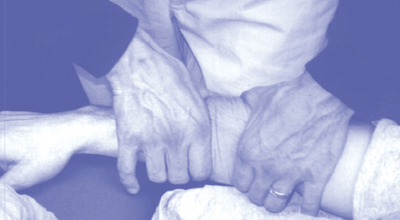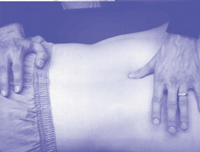
Features
Practice
Technique
Don’t forget the fascia
The field of massage therapy has grown so fast that the number of
catchwords included in its repertoire has had to expand in order to
keep up. In doing so, many different types of techniques get taught,
strained and altered until only a small fragment of the original
concept remains in tact.
September 15, 2009 By Brad McCutcheon
Part one of three
The field of massage therapy has grown so fast that the number of catchwords included in its repertoire has had to expand in order to keep up. In doing so, many different types of techniques get taught, strained and altered until only a small fragment of the original concept remains in tact.
Fascial treatment is no exception, and it is no wonder that the understanding of what it really is has been slightly misunderstood by a large percentage of our colleagues.

|
|
|
To give you some perspective on the age of fascial treatment, Dr. J.D. Balkham M.D. was quoted in 1887 saying that “the use of lubricants in every case would be considered by experts in the art of massage as a sure index of ignorance, and lack of experience and tact on the part of the operator….” 1 He goes on to state that anyone can give the perception of skilled hands if they use enough lubrication on their patients.
Interesting that this perception was taken by a physician that practised and taught the art of massage in the city of Boston, Massachusetts.
Dr. Andrew Taylor Still, the founder of Osteopathic Medicine, wrote extensively in 1899 about the fascia stating: “the fascia gives one of, if not the, greatest problems to solve as to the part it takes in life and death. It belts each muscle, vein, nerve, and all the organs of the body. It is almost a network of nerves, cells and tubes running to and from it … By its action we live and by its failure we shrink, or swell and die.” 2

|
|
|
|
In the science of modern therapeutic massage we owe much to Dr. Douglas Graham, John Grosvenor (1742-1823), Peter Henrik Ling (1766-1839) 3, Dr. Fred Mitchell 4, Dr. Ida Rolf, Dr. Irvin M. Korr 5 all of which have supplied some of the scientific background that we now use to prove what it is we do when treating fascia.
When treating a patient, it is
very easy to get results, it is much more difficult to be able to explain your results and in doing so be able to reproduce them. Reproducing
your results and explaining them is what will evolve not only you as a therapist but massage therapy as a profession. Explaining your results starts with an understanding of the physiology and, of course, anatomy you are treating.
Does Swedish massage using lubrications free up fascial restrictions? An interesting questions to ponder … the answer physiologically, in a word, is no. Fascial restrictions most often occur in a direction opposed to the primary fibre direction of the tissue. Myers 6, Oldham, Tyndall, 7 Feitis and Shultz 8 all came to this same conclusion. Swedish massage techniques traditionally use longitudinal strokes that change fluid pressures in the tissues but are not sustained enough to create thixotropic changes in the tissue and molding as described by Lederman 9.
References:
- J.D. Balkham, 1887, Reprinted in Massage Heritage Times, Volume 1 Issue 1, January 2000.
- Dr. A.T Still 1899. “Philosophy of Osteopathy” Academy of Applied Osteopathy reprinted 1995. American Academy of Osteopathy Indianapolis IN pg 164
- Massage Heritage Times, Volume 1 Issue 2 April 2000, pg 1
- Dr. Fred Mitchell Jr. Do. FAAO. FCA, “The Muscle Energy Manual” Volume 1, MET Press, East Lansing, Michigan
- Dr. Irvin M. Korr, “The Physiological Basis of Osteopathic Medicine,” Insight Publishing, 1982 Williston Park NY
- T.W. Myers, “The Anatomy Trains:, Journal of Bodywork and Movement Therapies, 1997, 1(3) 134-145
- Oldham Tyndall, “Fascial Distortion Model,” taken from notes during a conference 1996 New England
- Feitis And Shultz, “The Endless Web,” North Atlantic Books, 1996 Berkeley California
- E. Lederman, “The Fundamentals of Manual Therapy,” Churchill Livingstone, 1997, Edinburgh
| In his book on the Fundamentals of Manual Therapy, he paraphrases McGeown et al stating: “increasing the force of (external) compression also increases the flow rate of the lymph and fluid motion between compartments. Nowhere in the hundreds of sources in Lederman’s Fundamentals of Physiology (9) is there mention of creating change in connective tissue, lengthening of fascia or permanent range changes using compressive, type techniques. Compressive type techniques are all that can be accomplished by using a lubrication over the tissue, regardless of how long you maintain pressure. Fascial Treatment can only be accomplished by sustained stretching, indirect tissue manipulation, and neuro-muscular techniques. (More in part 2) Don’t forget the fascia! Anatomically there exists no place on the body In the next article we will explore the physiology behind fascial In the mean time I wish you all great success in your practices and ask |
Print this page